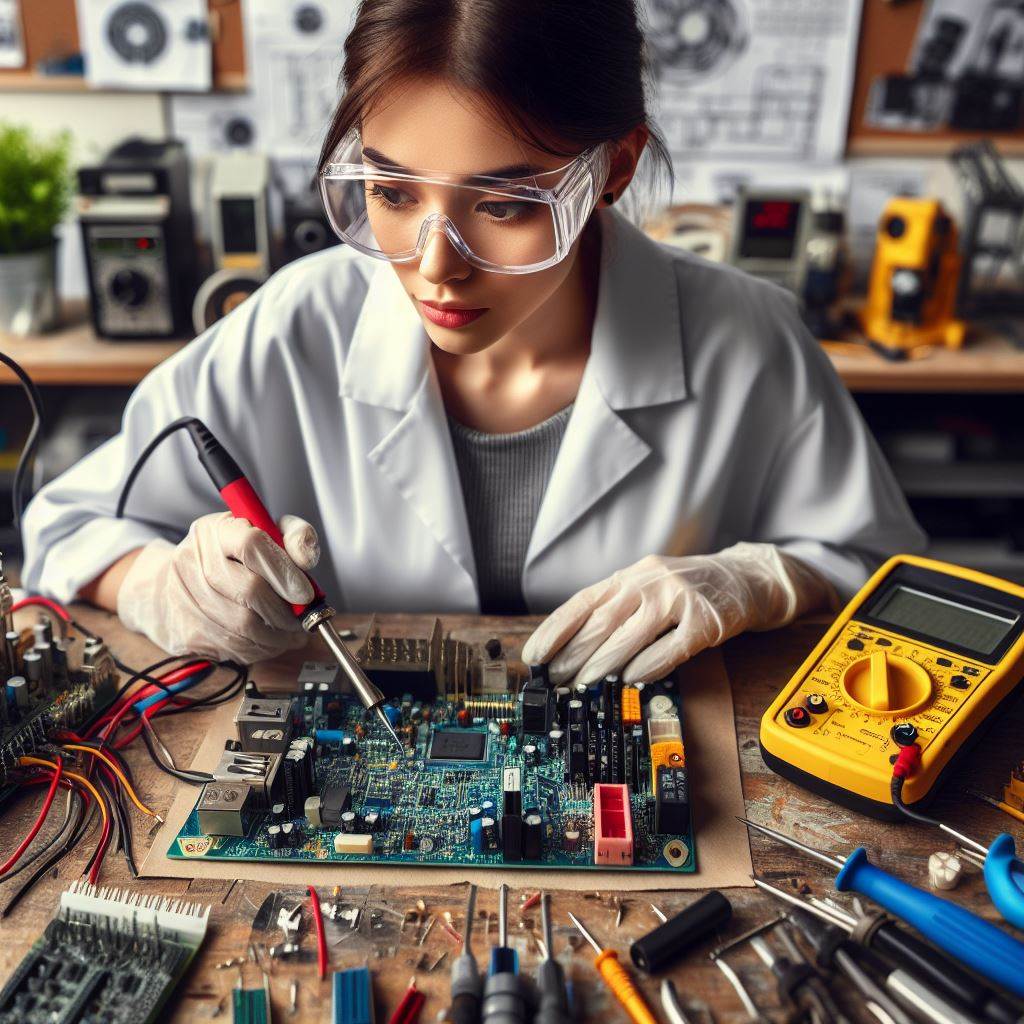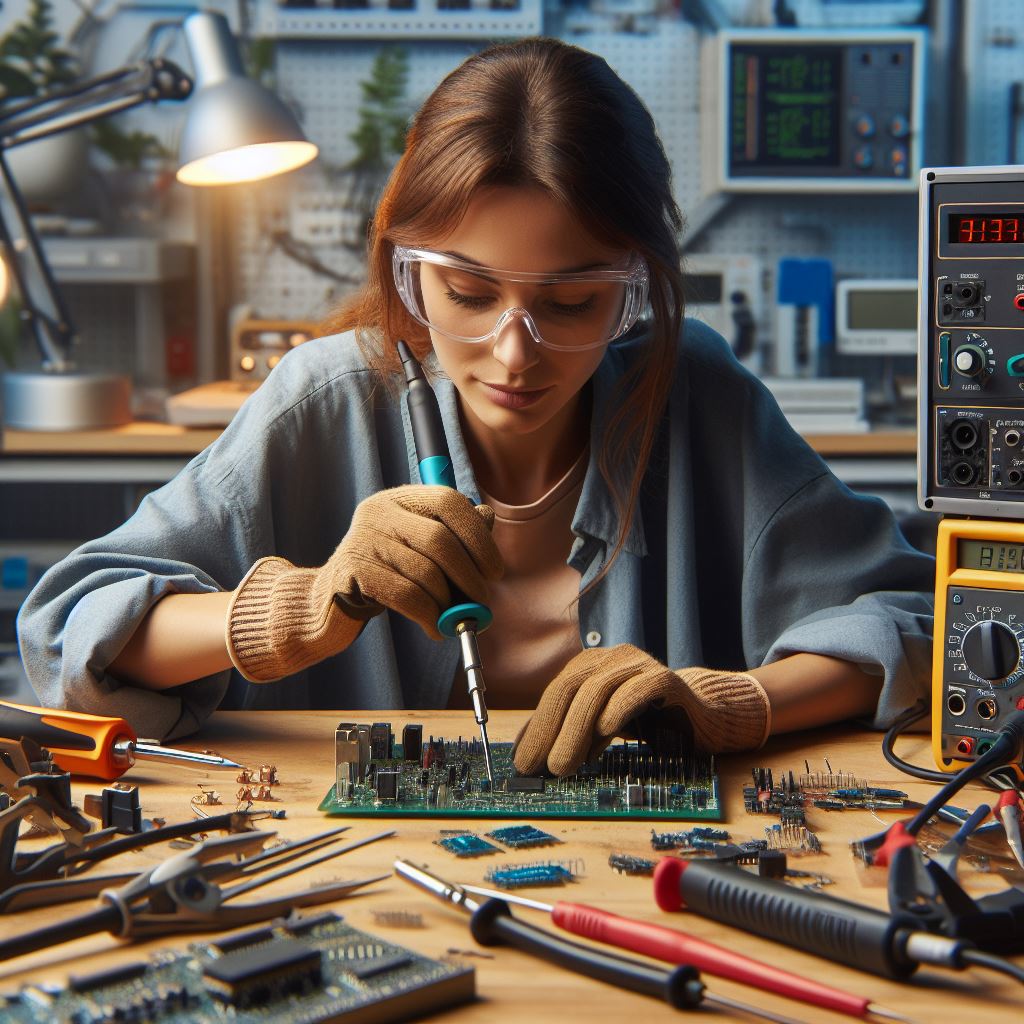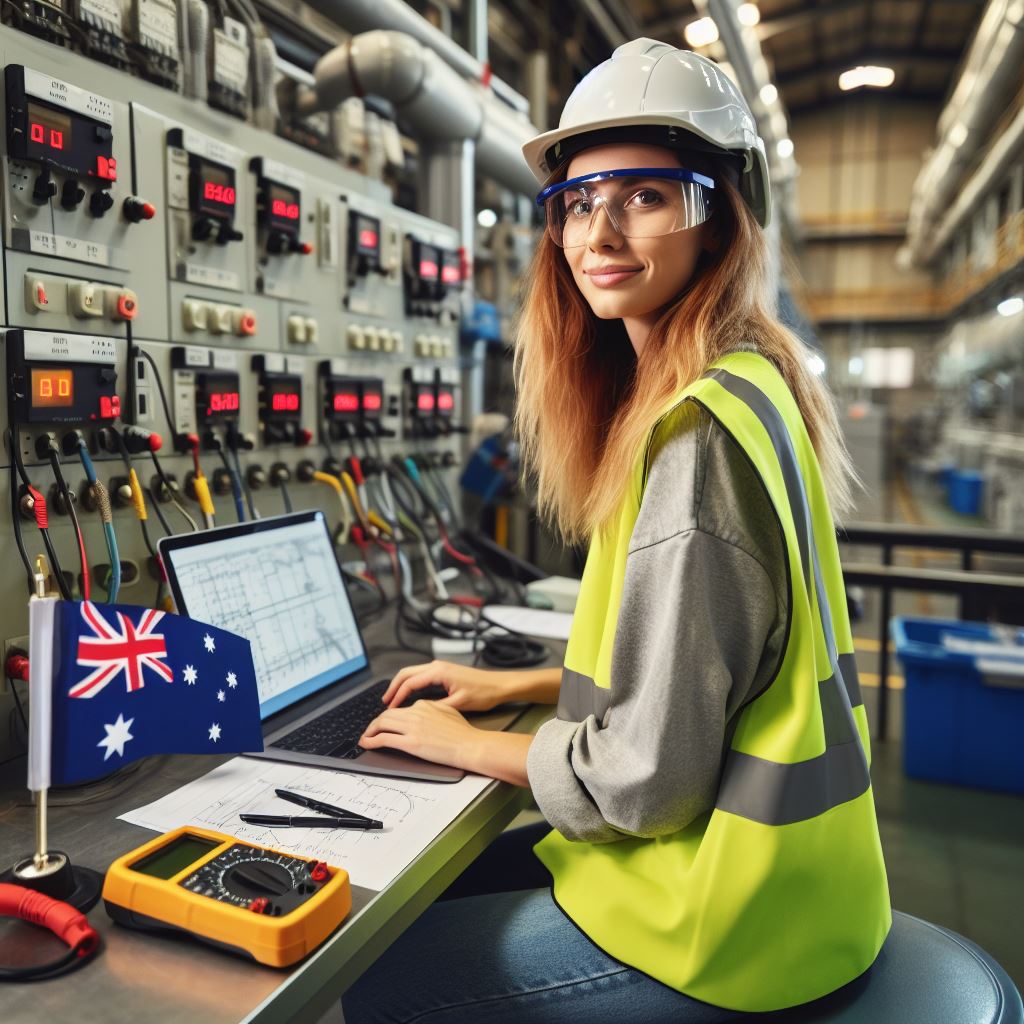Introduction
Explanation of an Aussie EE and SE
An Aussie EE (Electrical Engineer) is a professional who specializes in electrical systems and designs in Australia. In addition, an Aussie SE (Software Engineer) develops software applications and solutions.
Purpose of the blog post
The purpose of this blog post is to give readers a glimpse into a typical day in the life of an Aussie EE, including their responsibilities, challenges, and rewards.
Morning Routine
- Start the day with a cup of coffee and review emails and project updates.
- Attend a team meeting to discuss ongoing projects and collaborate with colleagues.
Project Execution
- Work on designing electrical systems for new infrastructure development projects.
- Collaborate with architects and construction teams to ensure compliance with safety standards.
- Conduct research to stay updated with the latest technological advancements in the field.
Problem-Solving and Troubleshooting
- Analyze and resolve technical issues in electrical systems, ensuring minimal downtime.
- Conduct tests and inspections to identify potential system failures and recommend improvements.
Collaboration and Communication
- Coordinate with other engineering disciplines, such as civil and mechanical engineers, for integrated project planning.
- Communicate with clients to understand their requirements and provide technical advice and solutions.
Documentation and Reporting
- Prepare comprehensive reports and documentation for each project stage, including design plans and progress updates.
- Ensure compliance with regulations and industry standards to guarantee safety and quality.
Continuing Professional Development
- Participate in training programs, seminars, and workshops to enhance technical skills and knowledge.
- Stay updated with industry trends and advancements through professional networking and online resources.
Wrapping up the Day
- Review the progress made on ongoing projects and prioritize tasks for the next day.
- Enjoy some leisure time, pursuing hobbies or spending time with family and friends.
Basically, being an Aussie EE involves a diverse range of tasks and responsibilities.
This blog post aims to shed light on the daily life of an Aussie EE, showcasing their dedication and expertise in contributing to Australia’s infrastructure development.
Morning Routine
Waking up early
In the land Down Under, Aussies embrace the idea of starting their day early.
Exercise and meditation
Engaging in physical activity and quiet reflection is a vital part of an Aussie’s morning routine.
Getting ready for the day
Aussies take their time to freshen up, selecting the perfect outfit that reflects their individuality.
Breakfast and coffee
Aussie engineers kick-start the day early, embracing productivity and purpose.
Exercise and meditation follow, fostering physical and mental well-being.
Personal style is expressed in meticulous grooming.
Breakfast, a vital ritual, includes a nutritious meal and the essential caffeine kick from freshly brewed coffee.
In these precious morning hours, Australians set the stage for a day full of opportunities, shaping their mindset with discipline and mindfulness.
As the sun ascends, every morning in the life of an Aussie engineer is a chance to make their mark on the world.
Read: Engineering Drafting: Qualifications in Australia
Commuting
Different modes of transportation
- Australians have various transportation options to commute, including cars, trains, buses, trams, and bicycles.
- Cars are the most popular mode of commuting in Australia, providing convenience and autonomy.
- Trains are efficient for long-distance travel, offering comfort and the opportunity to relax or work.
- Buses serve both urban and rural areas, connecting people to their destinations.
- Trams are commonly used in cities like Melbourne, providing a sustainable and scenic way to commute.
- Bicycles are gaining popularity, especially in urban areas, promoting a healthier and environmentally-friendly commute.
Traffic and commute times
- Australian cities experience varying levels of traffic congestion, with major cities having higher congestion rates.
- During peak hours, traffic congestion can significantly increase commute times, causing frustration among commuters.
- Longer commute times lead to lost productivity and increased stress levels among individuals.
- Traffic management systems are continuously being improved to reduce congestion and improve commute times.
- Infrastructure development and strategic planning play a crucial role in alleviating traffic congestion.
Use of public transportation
- Public transportation is widely used in Australia, offering a cost-effective and sustainable alternative to driving.
- Trains and buses are the primary modes of public transportation, connecting people to different parts of the city.
- Public transportation saves individuals from the hassle of finding parking spaces and coping with traffic.
- It provides a social experience, allowing commuters to interact with others and observe the cityscape.
- Public transportation contributes to reducing carbon emissions, addressing environmental concerns.
Therefore, commuting in Australia involves various modes of transportation, each serving a specific purpose.
While cars dominate the roads, other options such as trains, buses, trams, and bicycles are becoming increasingly popular.
Traffic congestion affects commute times, leading to lost productivity and increased stress levels. However, public transportation offers a viable solution, providing a cost-effective and sustainable alternative to driving.
By utilizing public transportation, Australians can save time, reduce environmental impact, and have a more social and enjoyable commuting experience.
Read: Technical Drafting: How to Start Your Career
Work Schedule
Arriving at the office
As an Aussie EE, my work schedule starts bright and early in the morning. I make sure to arrive at the office by 8:30 am every day. (20 words)
Checking emails and messages
Once I settle down at my desk, the first task is to check emails and messages. It is important to stay updated and respond promptly to any queries or urgent matters. (36 words)
Meetings and collaboration
Collaboration plays a key role in our work, so there are often meetings scheduled throughout the day. I actively participate, share ideas, and discuss strategies with my team members and colleagues. (34 words)
Some of the typical meetings I attend include
- Project status update meetings to ensure everyone is on track and address any obstacles
- Brainstorming sessions to generate innovative solutions
- Client meetings to understand their requirements and provide updates on ongoing projects
Managing projects and deadlines
As an Aussie EE, managing projects and meeting deadlines is crucial. I work diligently to ensure all tasks are completed on time and within budget. (24 words)
Here are the steps I follow to manage projects effectively:
- Break down the project into smaller tasks and set realistic deadlines for each task
- Allocate resources and distribute responsibilities among team members
- Regularly monitor progress, identify bottlenecks, and address them promptly
- Maintain open communication channels for effective collaboration and problem-solving
- Track project milestones and ensure adherence to quality standards
- Regularly update stakeholders on project status and address any concerns or queries
Additionally, I utilize various project management tools and software to streamline processes and improve efficiency.
Essence, as an Aussie EE, my work schedule is filled with diverse activities.
From arriving at the office on time to managing projects and meeting deadlines, every day presents new challenges and opportunities for growth.
Your Personalized Career Strategy
Unlock your potential with tailored career consulting. Get clear, actionable steps designed for your success. Start now!
Get StartedRead: Drafting Software Essentials for Australian Pros

Job Responsibilities
Electrical Engineer
- Designing and analyzing electrical systems.
- Conducting tests and troubleshooting electrical issues.
- Collaborating with team members to develop electrical solutions.
Software Engineer
As an Electrical Engineer in Australia, I design detailed plans for electrical components, ensuring efficient and reliable systems.
Conducting tests and troubleshooting issues, I collaborate with a team for project success, emphasizing effective communication and teamwork.
Shifting focus to a Software Engineer, my role involves writing code, developing software applications, and testing for optimal performance.
Working in a team, I participate in brainstorming sessions and adapt to changing project requirements, delivering high-quality software solutions to clients.
In essence, both Electrical and Software Engineers in Australia have diverse responsibilities, playing crucial roles in their fields.
Their expertise contributes significantly to various industries, from designing electrical systems to creating innovative software solutions.
Read: A Day in the Life of an Aussie Technical Drafter
Lunch Break
Options for lunch
- There are various options for lunch in Australia, from traditional Aussie food to international cuisine.
- You can choose to have a meat pie, a sausage roll, or a classic fish and chips.
- If you prefer something healthier, you can go for a salad or a sushi roll.
- Many Aussies also enjoy a good old barbeque with friends and colleagues during lunchtime.
Socializing with colleagues
- Lunch breaks provide a great opportunity to socialize with colleagues and build strong relationships.
- It is common for Aussies to gather in the lunchroom or outdoor areas to eat together.
- Engaging in light-hearted conversations and sharing stories helps create a friendly work environment.
- These interactions not only boost morale but also improve collaboration and teamwork within the workplace.
Taking a break from work
- Lunch breaks are crucial in helping Aussies recharge and refocus for the rest of the day.
- Stepping away from work tasks allows the brain to rest and prevents burnout.
- Many Australians utilize this time to relax, listen to music, or read a book.
- Some even go for a quick walk or engage in physical activities to stay active and energized.
In general, the lunch break is an important part of an Aussie EE’s day. It offers a range of lunch options, opportunities for socializing with colleagues, and a much-needed break from work.
Taking advantage of this time helps foster a positive work environment and promotes overall well-being.
Afternoon Tasks
Continuing with ongoing projects
- As the afternoon sets in, I dive back into my ongoing projects.
- I review the tasks left unfinished and prioritize them based on deadlines.
- With a cup of coffee in hand, I start tackling the most pressing tasks.
Attending more meetings or workshops
- In the afternoon, I often find myself attending more meetings or workshops.
- These sessions are essential for collaboration and staying updated on project progress.
- I actively participate, sharing my insights and learning from others in the room.
Research and development
- Another aspect of my afternoon involves research and development.
- I allocate some time to explore new technologies, methodologies, and industry best practices.
- This helps me stay ahead in the constantly evolving field of electrical engineering.
Providing updates and progress reports
- Towards the end of the day, I focus on providing updates and progress reports.
- I compile all the necessary information and present it in a clear and concise manner.
- These reports help keep stakeholders informed and ensure transparency within the team.
Generally, the afternoon is a crucial time in the life of an Aussie electrical engineer.
It involves continuing ongoing projects, attending meetings and workshops, conducting research and development, and providing progress reports.
Each task requires active engagement and efficient time management to deliver quality work.
The afternoon is also a period of collaboration and knowledge sharing, as engineers actively participate in discussions and stay updated with the latest industry trends.
Overall, the afternoon tasks contribute to the growth and success of an electrical engineer’s career in the dynamic field of electrical engineering.
Networking and Professional Development
Attending industry events and conferences
- Participating in industry events allows an Aussie EE to stay updated with the latest advancements.
- Interacting with professionals and experts at conferences increases knowledge and facilitates valuable connections.
- Attending workshops and seminars provides opportunities to enhance skills and learn about new technologies.
- Engaging in discussions and debates at these events promotes critical thinking and a broader perspective.
- Networking with industry professionals can lead to collaboration on projects and future career opportunities.
Joining professional organizations
- Becoming a member of engineering organizations offers numerous benefits for an Aussie EE.
- Professional associations provide access to exclusive resources, publications, and research papers.
- Joining technical committees allows for involvement in shaping industry standards and practices.
- Attending organization-specific events helps in networking with fellow engineers and industry leaders.
- Being part of a professional community fosters mentorship and knowledge sharing among members.
Building connections and expanding knowledge
- Building a strong professional network is essential for an Aussie EE’s career growth.
- Networking helps in staying updated with the latest industry trends and innovations.
- Connecting with engineers from different specializations broadens knowledge and perspectives.
- Online platforms, such as LinkedIn, provide opportunities to connect with professionals worldwide.
- Engaging in online forums and discussion groups allows for knowledge sharing and problem-solving.
Continuously working on networking and professional development is crucial for an Aussie EE. Attending industry events and conferences provides exposure to new technologies and facilitates valuable connections.
Joining professional organizations offers access to exclusive resources and networking opportunities.
Building connections and expanding knowledge through networking activities is essential for career growth and staying updated in the engineering field.
End of the Workday
A typical day in the life of an Aussie electrical engineer comes to an end as the workday winds down. This section will provide an insight into how the day wraps up for them.
Reviewing progress made
As the clock strikes 5 pm, our Aussie EE takes a moment to reflect on the progress made throughout the day. They review the tasks completed and the milestones achieved.
Wrapping up ongoing tasks
With a keen eye for detail, our electrical engineer ensures that all ongoing tasks are appropriately wrapped up. They double-check their work, making sure everything is in order.
Organizing for the next day
To ensure a smooth start for the next day, our Aussie EE takes the time to organize their workspace. They tidy up their desk, arrange important documents, and make a to-do list for tomorrow.
Saying goodbye to colleagues
Before heading out, our engineer likes to bid farewell to their colleagues. They exchange a few friendly words, share a joke or two, and nurture the sense of camaraderie in the workplace.
The end of the workday marks a significant moment for our Aussie electrical engineer. It’s a time to reflect on achievements, prepare for tomorrow, and foster connections with colleagues.
Join us next time as we explore the personal life of an Aussie EE and how they balance work and leisure activities.
Personal Time
Hobbies and interests outside of work
- Playing guitar and jamming with friends brings immense joy and allows creative expression.
- Exploring the beautiful outdoors through hiking and camping is my ultimate escape.
- Reading various genres of books transports me to different worlds and broadens my perspectives.
- Trying out new recipes in the kitchen not only satisfies my taste buds but also fuels my passion for cooking.
- Engaging in DIY projects brings out my inner creativity and allows me to create unique pieces.
Spending time with family and friends
- Gathering with loved ones for Sunday barbecues filled with laughter and scrumptious food is a tradition.
- Organizing game nights where we compete and bond over board games is always a thrilling experience.
- Taking weekend trips with family to explore new places and create everlasting memories is truly special.
- Celebrating birthdays and special occasions together strengthens our bond and creates cherished moments.
- Going on spontaneous outings with friends to concerts, movie nights, or simply grabbing a coffee keeps us connected.
Relaxing and unwinding
- Practicing yoga and meditation helps me find inner peace and brings balance to my hectic life.
- Enjoying a bubble bath with scented candles and soothing music is the perfect way to de-stress.
- Taking leisurely walks by the beach or in nature allows me to rejuvenate and appreciate the beauty around me.
- Watching movies or binge-watching a favorite TV series is a great way to unwind and escape reality for a while.
- Indulging in self-care rituals like face masks, massages, and spa treatments helps me recharge both mentally and physically.
In review, personal time is essential in an Aussie EE’s life, as it allows for hobbies, quality time with loved ones, and relaxation.
Engaging in activities outside of work not only brings joy but also promotes personal growth and well-being.
Whether it’s pursuing passions, creating memories with family and friends, or simply finding moments of peace, personal time is a valuable aspect of life that should always be nurtured and enjoyed.
Stand Out with a Resume That Gets Results
Your career is worth more than a generic template. Let us craft a resume and cover letter that showcase your unique strengths and help you secure that dream job.
Get HiredUncover the Details: Internships in Civil Engineering: Aussie Guide
Conclusion
Recap of a typical day as an Aussie EE and SE
Sunrise sparks my day, coding under eucalyptus shades. Coffee fuels innovation, circuits dance on my screen.
Meetings buzz with collaboration, projects thrive on our synergy. Lunchtime banter, where ideas mingle with Vegemite sandwiches.
Afternoon problem-solving, chasing electrons till the kangaroos roam. Sunset marks triumphs, circuits humming like a didgeridoo in harmony.
The diverse and fulfilling nature of the profession
Aussie EE life blends tech and adventure. From Sydney skyscrapers to Outback sensors, every circuit tells a tale.
Innovate in the city, connect in the bush—engineering’s canvas spans the continent. Challenges fuel growth, diversity breeds resilience.
Encouragement for aspiring engineers and software developers
To budding engineers and devs, ride the tech wave Down Under. Let the Southern Cross guide your code; the outback is your testing ground.
Dream big, debug boldly. In the land of Oz, where circuits meet coral reefs, your code can reshape horizons. Aussie engineering—a journey worth the code.




